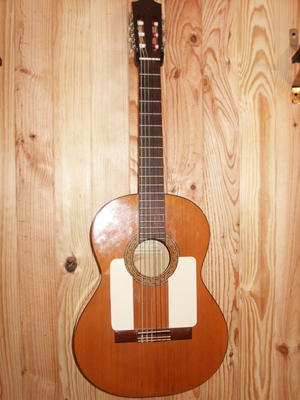The traditional flamenco guitar is made of Spanish cypress and spruce , which accounts for its characteristic body color, and is lighter in weight and a bit smaller than a classical guitar, to give the sound a "brighter" and percussive quality. The flamenco guitar is also used in several different ways from the classical guitar, including different strumming patterns and styles, as well as the use of a cejilla (capo) in many circumstances.
Volume has traditionally been very important in flamenco construction, as guitarists needed to be heard over the sound of the dancers' nailed shoes.
The flamenco guitar, in contrast to the classical, is often equipped with a tap plate called golpeador, commonly made of transparent plastic, similar to a pick guard, whose function is to protect the body of the guitar from the rhythmic finger taps (golpes). Originally, flamenco guitars were made with wooden tuning pegs similar to a violin. Some guitarists still prefer these pegs to the classical style modern tuning gears. It is widely accepted that more weight in the headstock can improve sustain; unsurprisingly, less weight can result in quicker attack, a desirable quality in a flamenco guitar. This could explain why many flamenco players still favor the traditional pegs. The action, or the height of the strings above the fingerboard, is generally lower (<3mm at the 12th fret) than that of a classical guitar. This aids faster playing, especially during fast scale passages called picados, but can lead to some fret buzz, also a frequent feature of the traditional 'flamenco' sound. Also, the lower string height greatly helps reduce fatigue of the left hand over lengthy performances.
In short, flamenco guitars are better suited for flamenco music than classical guitars. Some modern flamenco guitars, however, use similar materials to high-end classical guitars. These guitars hope to capture some of the sustain achieved by concert calibre classical guitars while retaining the volume and attack associated with flamenco.
Sal Bonavita - Flamenco Guitarist
Loading the player...
Technique
Flamenco is played somewhat differently from the classical guitar, utilizing different strumming patterns and techniques. Flamenco is commonly played using a cejilla (capo), which can somewhat make the guitar sound more brilliant and percussive. However, the main purpose in using a cejilla is to change the key of the guitar in order to suit the singer's vocal range. In addition to the techniques common to classical guitar, flamenco guitar technique is uniquely characterized by the following:- Golpe: Percussive finger tapping on the soundboard at the area above or below the strings. This requires a golpeador (tap-plate) in order to protect the surface of the guitar.
- Picados: Single-line scale passages performed apoyando but with more attack and articulation.
- Rasgueado: Strumming done with outward flicks of the right hand fingers, done in a huge variety of ways. A nice rhythmic roll is obtained, supposedly reminiscent of the bailaor's (flamenco dancer) feet and the roll of castanets.
- Alzapua: A thumb technique which has roots in oud plectrum (pick) technique. The right hand thumb is used for both single-line notes and strummed across a number of strings. Both are combined in quick succession to give it a unique sound.
- Tremolo: The technique of playing a bass line underneath a treble line consisting of rapidly repeating notes, often over a chord (i.e., with the same treble note over and over), although tremolos can become very complex. The effect is of two separate instruments playing the bass and treble lines, respectively.
